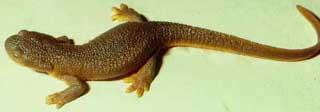- Rough-skinned newt
Taxobox | name = Rough-skinned Newt
status = LC | status_system = IUCN3.1
trend = stable

image_width = 240px
regnum =Animal ia
phylum = Chordata
classis =Amphibia
ordo =Caudata
familia =Salamandridae
genus = "Taricha "
species = "T. granulosa"
binomial = "Taricha granulosa"The rough-skinned newt ("
Taricha granulosa") is aNorth America nnewt known for its strong poison. They are available in some places as pets, sometimes with names "Oregon newt" or "orange-bellied newt." However the "Oregon newt" is more than likely a newt from California that looks similar. Oregon does not allow the commercial sale of these newts.Subspecies
"T. granulosa" is divided into two subspecies. Both have rough or granular skin, except for breeding males, which additionally exhibit swollen vents and cornified toe pads.
* The rough-skinned newt ("T. g. granulosa") is light brown to brownish-black above with an orange or yellow belly. In some populations, the back has dark blotches. They are between 13 to 22 cm long.
* The Crater Lake newt or Mazama newt ("T. g. mazamae") is darker above and brighter below than "T. g. granulosa" and may also have dark blotches below. The validity of this subspecies, which is exclusive to the region ofCrater Lake ,Oregon , is disputed by some researchers because the newts onGravina Island ,Alaska , are very similar.Toxicity
Many
newts producetoxins to avoidpredation , but the toxins of the genusTaricha are particularly potent. One thirtieth of the toxin present in the skin of an average adult rough-skinned newt is sufficient to kill a healthy adult human.Fact|date=December 2007 Toxicity is generally experienced only if the newt is ingested, although there are reports that some individuals experience skin irritation after dermal contact.Toxin
The rough-skinned newt possesses
tetrodotoxin , which in this species was formerly called "tarichatoxin". This toxin binds to sodium channels in nerve cells and interferes with the normal flow of sodium ions in and out of the cell. This has the effect of inducing paralysis and death.Toxin Resistance and Predation
Throughout much of the newt’s range, the
common garter snake ("Thamnophis sirtalis") has been observed to exhibit resistance to the tetrodotoxin produced in its skin. While in principle the toxin binds to a tube shaped protein that acts as a sodium channel in the snake's nerve cells, researchers have identified a genetic disposition in several snake populations where the protein is configured in such a way as to hamper or prevent binding of the toxin. In each of these populations, the snakes exhibit resistance to the toxin and successfully prey upon the newts. Toxin resistant garter snakes are the only known animals today that can eat a T. granulosa newt and survive.In evolutionary theory, the relationship between the rough-skinned newt and the common garter snake is considered an example of
co-evolution . The mutations in the snake’s genes that conferred resistance to the toxin have resulted in a selective pressure that favors newts which produce more potent levels of toxin. Increases in newt toxicity then apply a selective pressure favoring snakes with mutations conferring even greater resistance. This cycle of a predator and prey evolving to one another is sometimes termed anevolutionary arms race and has resulted in the newts producing levels of toxin far in excess of what is needed to kill any other conceivable predator.Location
Habitats of rough-skinned newts are found throughout the west coast of the US. They are uncommon east of theCascade Mountains though occasionally found (and considered exotic, and possibly artificially introduced) as far as Montana. The southern range extends to Santa Cruz,California and as far north asAlaska . [Natureserve Explorer]See also
*
Salamander
*California Newt
*Red Bellied Newt
*Salamandridae References
*
*
* Geffeney, Shana L., et al. “Evolutionary diversification of TTX-resistant sodium channels in a predatorÂ-prey interaction”. Nature 434 (2005): 759–763.
*External links
Wikimedia Foundation. 2010.
